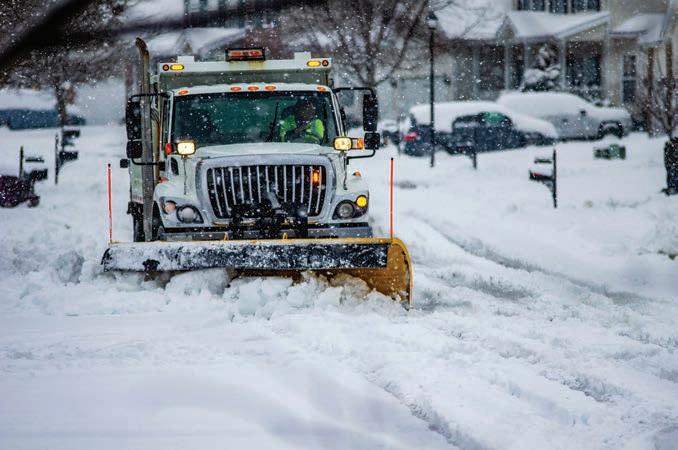
8 minute read
Not a one-size-fits-all solution to local a ordable housing crisis
As many are aware Colorado, like most of the country, has a housing crisis with a de cit of a ordable, attainable, and available housing. It’s in the headlines daily and has become a top priority for local elected leaders and state lawmakers. And like our entire state, Arapahoe County is appealing to new people who want to call it “home.” at’s why Arapahoe County is partnering with our 13 cities and towns to work on solutions that address this predicament. As local government leaders, we collectively understand and support housing coordination because we also recognize and respect each community’s unique challenges and di erences. We have a variety of tools at the local level that can help shape our housing strategy more quickly and e ciently than broader e orts.
In fact, some forecasts show Arapahoe County could add as many as 120,000 people by 2030. But while the appeal is understandable, our a ordable housing supply has not kept up with demand, which will be the case as our County continues growing.
Among large counties, Arapahoe County has one of the most diverse housing stocks in the state –meaning a sound variety of single-family homes, townhomes, and apartments. In fact, 64% of those housing units are owneroccupied. The County also has what is called middle housing–or duplexes and triplexes–that are already allowed in certain zone districts and planned unit devel-
Letters To The Editor
Misguided a ordable housing bill e approach being taken in SB213 is to displace local zoning rules with a statewide mandate to incorporate a ordable housing everywhere. is misguided worldview ignores the natural balance of market forces and neighborhood sensibilities. e real shame is that nothing in this 105-page radical masterpiece will resolve the actual housing troubles. Rather, it will simply move Colorado several steps closer to liberal utopia, which maintains an embarrassing track record of unsuccess.
Senate Bill 23-213 is a 105-page jerrycan of gasoline ready to pour onto the re of housing shortages in Colorado. e bill’s title alone is 148 words long.
SB213 sets out to “diagnose and address housing needs across the state.” e Department of Local A airs will manage “Several hundred million dollars for a ordable housing [that] will become available in the second half of 2023 due to the enactment of Proposition 123” (from the department’s website). at measure, approved by Colorado voters last year, authorizes one-tenth of 1% on federal taxable income taxes to be spent on a ordable housing.
Excessive housing costs, like so many other challenges that Coloradans face, are created by government meddling. We repeatedly hear opments across the County. On the downside, a significant number of residents are housing burdened – meaning one in three residents, or over 88,000, pay more than 30 percent of their income on housing. That’s a 13 percent increase since 2016.
The good news is that Arapahoe County has more than 108,500 new housing units approved and ready to be built — that’s housing for at least 284,000 individuals.
But for several complicated reasons, it is taking a long time for these approved units to be built. ose reasons include labor and supply chain shortages, developer priorities, and nancing backlogs for a ordable housing projects, which result in increasing capital costs due to market conditions. ere also are signi cant infrastructure costs — like water and sewer — that need to be built for both new and in ll housing projects. e County also lacks public transportation options to make transit-oriented development less car-dependent.
Another piece to the housing crisis is nding quality, long-term solutions for homelessness. We are currently working across the County to coordinate homelessness response and program o erings, including expanding shelter options, providing eviction support services and expanding navigator programs. Most of these services, however, have been funded by onetime federal dollars, so it is crucial that we nd a sustainable revenue source to continue these critical programs.
Like us, Governor Polis and our legislative delegation are interested in attacking the housing cri- sis. ey have proposed land-use legislation that seeks to encourage denser building in key urban areas and alter single-family zoning in Colorado cities. is is of concern because it would allow the state to build additional middle housing units without current local approvals. at’s why local governments— like your Board of County Commissioners and your mayors and city councils—are working diligently to nd solutions and proactively respond to the changing needs of our communities every day. We know a one-size- ts-all approach won’t work locally to increase housing a ordability, accessibility, and diversity. Local oversight takes time to ensure housing is safe for all within our community and services and infrastructure for new housing are readily available.
In the coming weeks and months, your elected leaders look forward to having more meaningful conversations about this topic and we urge you to get involved. Call your state representative and let them know how you feel about housing. Read up on the great work our cities and towns are doing. And look for future telephone town hall events at www.arapahoegov.com/townhall, follow us on social media, or subscribe to The County Line newsletter to stay informed.
The Arapahoe County Board of County Commissioners is made up of Carrie Warren-Gully, Jessica Campbell-Swanson, Jeff Baker, Leslie Summey and Bill L. Holen from the Democrats that “we must do everything possible to x this problem.” And I repeatedly respond that they do not possess the humility to “do everything possible.”
A study by the National Association of Homebuilders concludes that, “Regulations imposed by all levels of government account for 23.8% of the current average sales price of a new single-family home …” NAHB Chairman added that, “ is study illustrates how overregulation is exacerbating the nation’s housing a ordability crisis and that policymakers need to take bold steps to reduce or eliminate unnecessary regulations that will help builders increase the production of quality, a ordable housing.” e Colorado Legislature should “do everything possible” to address a ordable housing by weeding out costly regulations from the existing laws. en, watch the magic of free enterprise do what it has always done — respond to demand with attractive supply.
Adding to the cost of regulation is the $250% increase in lumber costs thanks to the Biden administration’s in ationary supply chain mess. is accounts for an additional $35,872 premium to the average house. If the Democrats were honest with themselves, they would direct their attentions to reducing in ationary housing regulations. But their religious devotion to government micromanagement concludes as it always does; treatments for the symptoms while clinging to the causation.
Mark Baisley
State senator for District 4, including rural Douglas County Woodland Park
Back assault-weapons ban
Cavitation (noun): the formation of an empty space within a solid object or body. is is the mechanism by which the ammunition from an assault-style weapon penetrates another person’s body. If that person happens to be a child, like the 19 children slaughtered at Robb Elementary on May 24, 2022; or one of the three 8- and 9-year-olds from the Covenant School in Tennessee on March 27; then the impact and penetration will essentially liquefy their organs. I challenge anyone reading this to nd a reason why any American citizen who is not in the military has a need to possess a weapon that can liquefy the organs of a child with the pull of a trigger.
I’ll save you some time: we do not need access to these weapons. ere is absolutely no reason to have unfettered access to these weapons. When the Bill of Rights was ratied in 1791, assault ri es had not yet been developed. I think we can easily assume that our Founding Fa- thers did not intend for the Second Amendment to be a free pass for untrained, average citizens to access rearms that are solely for the purpose of hunting and slaughtering other human beings, including children.
Voting to pass HB23-1230 and ban assault weapons in Colorado will send a number of crucial messages to Coloradans. It will tell us that our elected o cials are dedicated to the safety of their citizens. It will also tell us that they hold a great respect for our Founding Fathers, our Constitution, and the Second Amendment — as its original intention was not, in fact, to give citizens the right to weapons of war. And nally, most importantly, it will send the message to those who have survived the abject terror of being targeted by an assault weapon — that they matter, and everything will be done to prevent it from happening again.
To my fellow Coloradans reading this: get on Twitter, get on social media, and start sending emails to your elected o cials. We deserve better. Let’s show our neighbors in Tennessee who are currently outraged with their lawmakers about inaction on this issue; that we know how to organize and hold lawmakers accountable to protect their constituents.
Gina M. Myers Castle Rock
Warm Hearts Warm Babies serves hospitals, agencies across Colorado

BY TAYLER SHAW TSHAW@COLORADOCOMMUNITYMEDIA.COM

Surrounded by colorful fabric patterns, handmade baby items and frequent laughter, volunteers of the Warm Hearts Warm Babies nonpro t went to work on a Friday morning to put together layettes for organizations who need them.
e nonpro t has a list of roughly 40 agencies it delivers items to throughout Colorado, said Kathleen Williams, the nonpro t’s grant coordinator. e list includes the Children’s Hospital Neonatal Intensive Care Unit, Platte Valley Medical Center and Denver Medical Center.
“Warm Hearts is totally made up of volunteers,” said Sandi Powis, president of the board of directors. “Everyone’s volunteering with their heart and skills to make things for newborn (babies), preemies to help them get a good start in this world.”
Volunteers sew, knit, crochet and quilt items such as bibs, burp pads, jackets, hats and blankets. e items are assembled into a layette, which is a collection of clothing and accessories for newborn infants.

Each layette contains a quilt, two receiving blankets, bibs, burp pads, clothing and a goodie bag containing items such as a bottle, some diapers and a small toy. ese items are delivered in a handmade tote bag.
“All these items are made with love,” Powis said. “We don’t connect to the individuals personally. We deliver the layettes to hospitals, birthing centers, food banks — anyone that can help us help the newborn.” e nonpro t also o ers items for the neonatal intensive care units at hospitals in Colorado, such as positioning roles that are used to help support the infants.
A number of the mothers who receive these items are experiencing homelessness, sometimes living in shelters or in their cars, Williams said.
“We also provide clothing for babies that don’t survive, from tiny little babies to full-term babies,” Williams said. “We have clothing for them that we hand out at the hospitals.”
Included in those burial layettes is a cloth-made envelope intended for the parents to hold important items and memories, Powis said.
“It’s sad, but it’s so important,” Powis said. “And to know that a mom wouldn’t have to go out, or send her mom or her sister to go out and nd things for her precious one that has passed — that it can be given to them and that’s not a worry for them.”
How it began
e nonpro t’s origin dates back to 1996, when a woman named Victoria Swain gave birth to a stillborn infant, according to the nonpro t’s website. e hospital she was at could not provide a blanket or clothes for her infant, prompt- ing Swain to look into how she could help donate these types of items.
After recruiting some volunteers and spending a few years working through a di erent organization called Newborns in Need, in 2000, Swain and the other board members decided to create their own nonpro t: Warm Hearts Warm Babies.
Powis estimated the nonpro t currently has about 200 volunteers and 12 work groups throughout the state including in Arvada, Brighton, Littleton and ornton.
Powis is part of the work group in Conifer, where she lives. She joined the organization roughly six years ago.
“I’ve been doing things for babies for many years, donating to other groups, but they were all missing something. ere was no social connection with anyone else making things,” Powis said. “I found that they had a local organization up here in Conifer and it was like, that’s it — that’s one I can link up with. I can meet people right here in our community.”
Williams learned about the nonpro t through a quilt show, as representatives of the organization had a table at the event. Living in Aurora at the time, she initially joined the Aurora group. Since then, she has moved to Colorado Springs

SEE IN NEED, P15











